 

PROBE GT GLOSSARY -- Back
E Eibach Springs 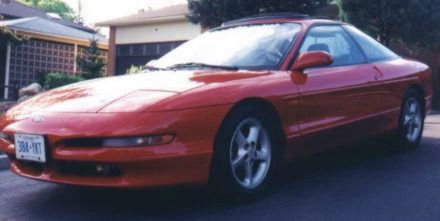
Engine Here is a picture of a Ford Duratec V6 that Demon@dial.pipex.com supposedly shoehorned into a Probe. It looks like a photo editing job to me.
 Just for kicks, I decided to make my own engine upgrade. A Mazda KL-V8!!! The best part is that the upgrade only took me 15
minutes!!! If you look carefully, you'll see that I even added an extra plug wire for the rear bank!(See "Air Intakes" for the unedited version of the picture)

Engine Mounts
See Motor Mounts Exhaust Manifold 
Check out my flex pipe. Looks like crap, however the inside is still intact.
F Fuel Additives
Chevron Techron "Clean Up" is cheap and effective. For dirty injectors, try 500mL of diesel fuel added to a tank of gas.
Filter
-- see Air Filter , and Oil Filter
Fuel Filter
For some reason, the fuel filter on the Mustang Cobra SVT and GT are half the price ($10) of the Probe GT unit. With some
minor work, I managed to use the Mustang filter in place of stock. Size-wise, the two filters are very similar. The gold coloured filter is the Mustang unit.

Friction Gear Spring
The failure of this washer-like object causes a clattering of the exhaust and intake camshafts gears against each other.
Replacing the rear friction gear involves removing the intake manifold, the rear cam cover and exhaust cam. The timing belt does not need to be removed to change the front or rear friction gear springs.
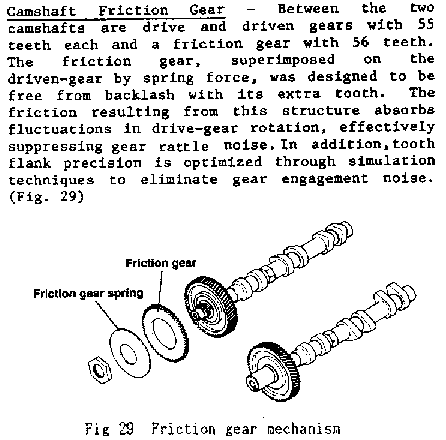
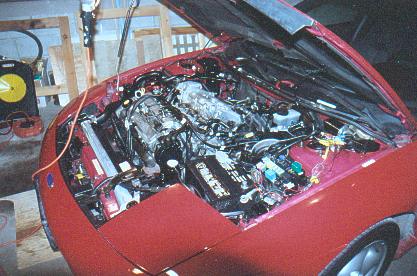 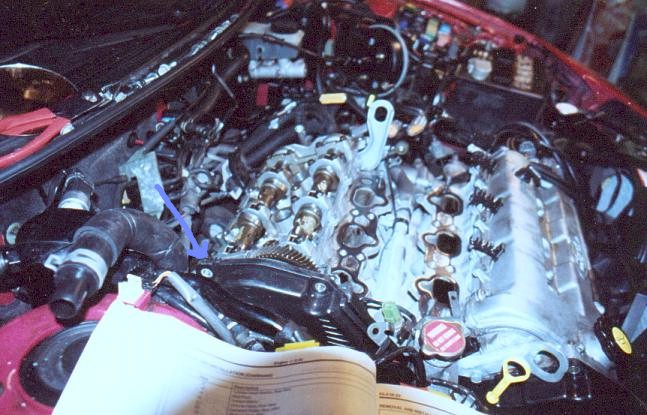
The friction gear spring on the rear bank is indicated above by the blue arrow. You can just barely see the gear teeth of the exhaust cam.
G
Gerry's Probe GT
In mid-October, 1999, I witnessed this naturally aspirated KL-03 1994 Probe GT turn 175HP at the wheels (ambient temperature around 14ēC).
List of Modifications:
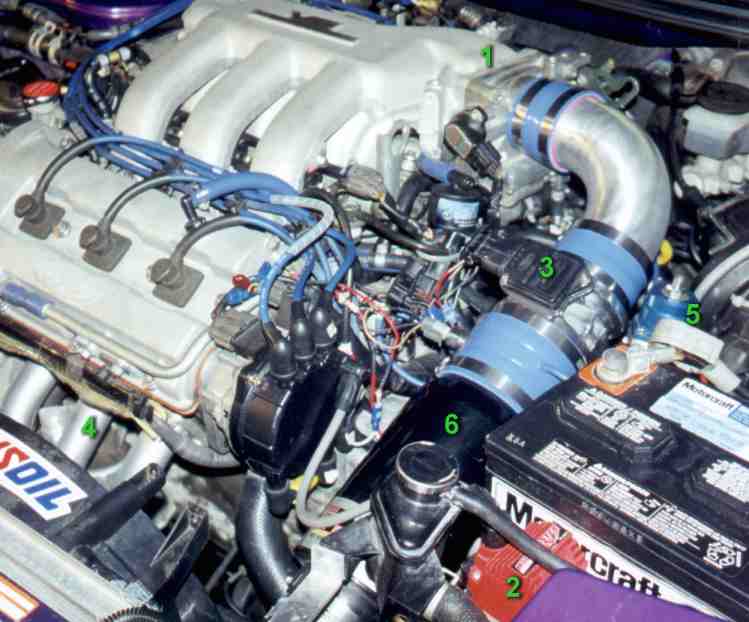
(1) Knife-edged air passage dividers just aft of the throttle body. No head work was done on the engine
(2) MSD Blaster external coil hook-up
(3) VAF to MAF conversion using a 55mm Ford MAF
(4) Custom headers (1.25" primaries feeding 1.75" secondaries)
(5) Fuel pressure regulator set for 58psi at WOT
(6) PRM intake
#2 VRIS plates removed
No cat
Free-flow exhaust
Custom chip (only worth 5HP)
Walbro 190LPH fuel pump
G-Tech Pro ( www.gtechpro.com )
This little pocket accelerometer plugs into your cigarette lighter. Another portable accelerometer that is more powerful and more expensive is made by Vericom ( www.vericom.org ).
The G-Tech is reportedly good at calculating 1/4 mile performance very consistently. Horsepower calculations are can also
be accurately measured, but proper technique is required. Some people are critical of the G-Tech's performance, especially
with regards to trap speed and HP calculations. With regards to 1/4 mile trap speed, Tesla, the manufacturer, claims that the
G-Tech attempts to give the exact trap speed at the very end of the 1/4 mile. Drag strips use timing lights that give the average
speed over the last 60ft. For this reason, G-Techs tend to read 2mph higher. Even if you don't buy this reasoning, the G-Tech is consistent with its 2mph high reading, and so as a relative comparative tool, it's still useful.
Technique
HP measurements from the G-Tech have been criticized because of the unusually high readings that can be generated. The
problem lies not in the device, but in the simpletons that are using it. Since the G-Tech measures acceleration, sudden jolts
from shifting gears (both in automatic and manual transmissions) can cause an acceleration spike. The G-Tech sees this spike
and thinks its the peak HP value. With a little bit of common sense and proper technique, this problem can be avoided.
When doing a HP run, there is no need to "put the pedal to the metal" until the tachometer is nearing the peak horsepower
range. Accelerate moderately so as to avoid "spikes', then floor it when you are say 1000 RPM from the peak HP RPM. Note:
when accelerating, don't doddle around too much as this may cause the G-Tech to "drift" and lose track of your exact speed -- crucial in HP calculations.
If you drive an automatic, you can floor the accelerator as soon as you are sure that the car won't downshift. Wind Resistance and Horsepower
Another thing to keep in mind when doing HP runs is the gear you are in. Because the G-Tech measures acceleration, not wheel HP, the horsepower number you get will be the wheel HP plus
wind resistance. It is therefore important that the G-Tech measure your peak HP in the same gear each time a run is performed. First gear seems like the easiest to do HP runs in, but
don't. The engine is putting a lot of work into accelerating the driveline instead of the car. This will cause your HP numbers to
be unexpectedly low. Second gear in most automobiles is usually good -- driveline acceleration losses are less, and wind resistance is not too high. G-Tech Manufacturer Claimed Precision
Table B
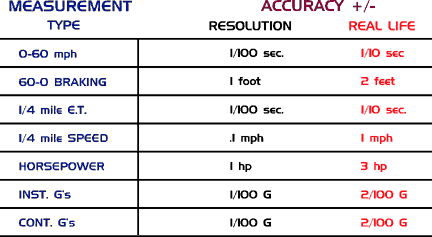
Horsepower Correlations
Once an HP value is obtained, it cannot be compared to dynamometer values because, as stated before, air resistance was
included in the value. What we need is a way to correlate dyno and G-Tech HP values. Luckily, SCC magazine (unknowingly) did just this in their '98 October issue when testing their '97 Probe GT project car.
SCC used the more expensive Vericom device to test acceleration in 2nd gear, the same gear most of us use the G-Tech to
measure HP. SCC also used a Dynojet to get wheel HP. Assuming more or less constant conditions, we can correlate the peak Dynojet
HP of 146 (see pg 120) to the peak Vericom HP of 127 (see pg 118). Note that a PRM intake was used in the test, so the
Vericom HP might actually be a little high (ram air effect, cold air, etc). It might be better then to compare the PRM-Intake-Dynojet number (146) with the stock Vericom HP number(124).
My own G-Tech HP numbers in 2nd gear (20C, nice day) show about 124HP, so my numbers are in line with SCC's Vericom.
Bottom line:
For a given G-Tech HP reading, the equivalent Dynojet HP reading would be about 1.150 to 1.177 times higher.
Here's a table of some of the numbers I've obtained on my '93 GT (see "Mike's Car" page for a description). All runs were
performed in second gear. "Hot" and "medium hot" engine refer to the degree that the engine had been warmed up. A "hot"
engine would have been fully warmed through regular driving followed by a few minutes of hard driving. The "weight" input into the G-Tech was 3100lbs (probably 50+lbs less than what the actual weight).
Av er ag e M ea su re d Va lu e Us in g G- Te ch |
Co ndi tio ns |
Nu mb er of Ru ns |
Co rr ela ted Dy noj et HP |
Est . Fly wh eel HP (1 7 % tra nn y los se s) |
12 4H P |
20° C, ho t en gin e |
2 |
14 4H P |
17 3 |
12 1 |
20 +° C, ho t en gin e |
2 |
14 1 |
17 0 |
13 4* |
17° C, me d. ho t en gin e |
1 |
15 6 |
18 8 |
13 8 |
-10 °C, ho t en gin e |
3 |
16 1 |
19 4 |
*unusually high given conditions
A dyno run will need to be done to verify the above estimates of horsepower. HP Calculations on Non-2nd Generation Probe GT's
The above correlation doesn't work well for other cars because of a different gearing+powerband combination, and air
resistance. One way to take air resistance out of the G-Tech HP measurement is to simply calculate how much air resistance
your vehicle is fighting at the speed at which peak HP occurs. By subtracting off the air resistance value, the HP number should be closer to the dynamometer value. Steps
1) Obtain a peak HP number using the G-Tech. Try to average three or more runs. Note the RPM that the peak HP occurs (or simply look up the spec for your engine).
2) Put the G-Tech into "G" mode so that it displays acceleration in G's. Accelerate to the same speed and RPM that the peak HP occurred at. Keep accelerating and note the number of G's. The number should be around 0.3.
3) Now, disengage the clutch. As the car decelerates, note the deceleration G's at the speed at which peak HP occurred. Expect a value around -0.05.
4) Take the absolute value of the deceleration G, and add it to the acceleration number: 0.3 + 0.05 = 0.35
Take the ratio of the new number and the acceleration G's and multiply it by the HP number obtained in (1)...
(0.3 / 0.35) * HP = Dynamometer HP
That's it! In theory this should work, although I have never performed any significant testing to find out. I would like to hear about any experiences you have with this technique.
H

Counter installed April 1, 1999 |










